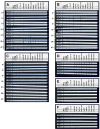Analysis of Humoral Immune Responses to Surface and Virulence-Associated Chlamydia abortus Proteins in Ovine and Human Abortions by Use of a Newly Developed Line Immunoassay
- PMID: 27194684
- PMCID: PMC4922118
- DOI: 10.1128/JCM.00351-16
Analysis of Humoral Immune Responses to Surface and Virulence-Associated Chlamydia abortus Proteins in Ovine and Human Abortions by Use of a Newly Developed Line Immunoassay
Abstract
The obligate intracellular bacterium Chlamydia abortus is the causative agent of enzootic abortion of ewes and poses a significant zoonotic risk for pregnant women. Using proteomic analysis and gene expression library screening in a previous project, we identified potential virulence factors and candidates for serodiagnosis, of which nine were scrutinized here with a strip immunoassay. We have shown that aborting sheep exhibited a strong antibody response to surface (MOMP, MIP, Pmp13G) and virulence-associated (CPAF, TARP, SINC) antigens. While the latter disappeared within 18 weeks following abortion in a majority of the animals, antibodies to surface proteins persisted beyond the duration of the study. In contrast, nonaborting experimentally infected sheep developed mainly antibodies to surface antigens (MOMP, MIP, Pmp13G), all of which did not persist. We were also able to detect antibodies to these surface antigens in C abortus-infected women who had undergone septic abortion, whereas a group of shepherds and veterinarians with occupational exposure to C abortus-infected sheep revealed only sporadic immune responses to the antigens selected. The most specific antigen for the serodiagnosis of human C abortus infections was Pmp13G, which showed no cross-reactivity with other chlamydiae infecting humans. We suggest that Pmp13G-based serodiagnosis accomplished by the detection of antibodies to virulence-associated antigens such as CPAF, TARP, and SINC may improve the laboratory diagnosis of human and animal C abortus infections.
Copyright © 2016, American Society for Microbiology. All Rights Reserved.
Figures



References
-
- Essig A, Longbottom D. 2015. Chlamydia abortus: new aspects of infectious abortion in sheep and potential risk for pregnant women. Curr Clin Microbiol Rep 2:22–34. doi:10.1007/s40588-015-0014-2. - DOI
-
- Walder G, Hotzel H, Brezinka C, Gritsch W, Tauber R, Würzner R, Ploner F. 2005. An unusual cause of sepsis during pregnancy: recognizing infection with Chlamydophila abortus. Obstet Gynecol 106(5 Pt 2):1215–1217. - PubMed
Publication types
MeSH terms
Substances
Grants and funding
LinkOut - more resources
Full Text Sources
Other Literature Sources
Medical

